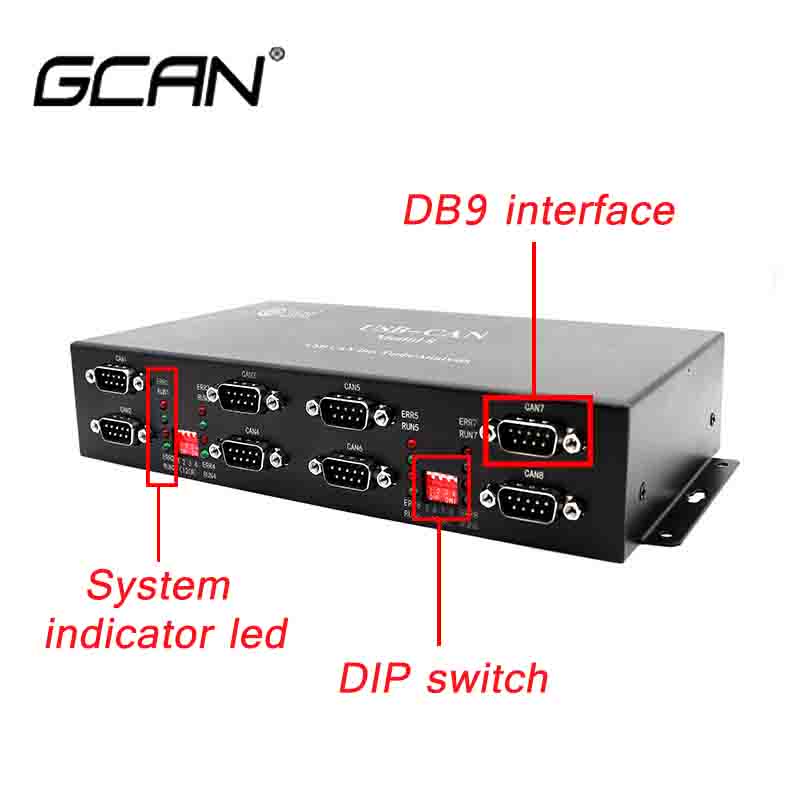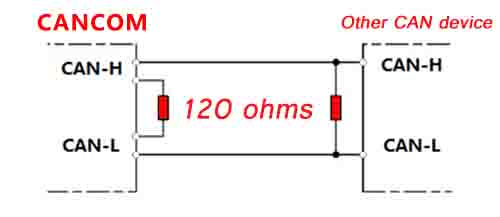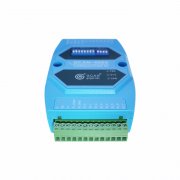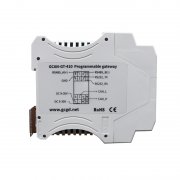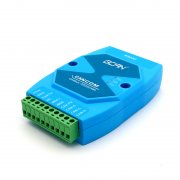How to know the CAN baud rate of CAN bus?
With the advancement of human science and technology, the original industrial RS232 bus can not meet the modern production needs, the use of CAN bus for industrial production is the consensus of most engineers. The CAN bus data transmission distance is long, the data transmission speed is fast, the anti-interference ability is strong, and there are many node devices that can be connected. As a producer, I believe that no one can resist the temptation brought by the CAN bus. The CAN baud rate is one of the most important features of the CAN bus. How do you know the baud rate of the CAN bus? The USBCAN adapter is a device that recognizes the CAN baud rate.
Take the USBCAN-MODULE 8 USB interface to CAN card of GCAN as an example. It is a powerful tool for CAN-Bus product development and CAN-Bus data analysis. It has many CAN interfaces, plug and play, etc. The best choice for multiple CAN bus users. USBCAN-MODUL 8-type USB interface to CAN card integrated CAN interface electrical isolation protection module, to avoid damage to the equipment due to transient overcurrent / overvoltage, enhance the reliability of the system in harsh environments . These devices can be connected to the computer and the corresponding CAN bus at the same time, and the data on the CAN bus can be browsed or downloaded online. So how do you connect without knowing the CAN bus baud rate?
Anyone with a basic knowledge of the CAN bus knows that if you want to have two different CAN buses connected to each other for communication, you need to do the following:
1. CAN_H (CAN high) should be connected to CAN_H, CAN_L (CAN low) should be connected with CAN_L. If you don't do this, there will be no communication.
2. The farthest ends of the CAN bus need to be connected with 120Ω resistors.
3. The CAN baud rate between the CAN bus needs to be consistent, do not expect the CAN bus with a CAN baud rate of 250Kbps and the CAN bus with a CAN baud rate of 500Kbps to achieve data transmission.
The first two points above can be easily solved as long as they are not too negligent, but the third point is consistent of CAN baud rate, sometimes it needs a little work, we take the CAN baud rate of the CAN bus on the car to explain. The general car manufacturer does not provide the user with a lot of information including the CAN baud rate. If the user or the developer wants to test or maintain the CAN bus, the CAN baud rate needs to be cracked.
USBCAN-MODUL Type 8 USB interface to CAN card mentioned above can be used with the ECANTOOLS software to get the CAN baud rate. One of the important functions is to automatically recognize the baud rate. It has “ Both Normal Silent Pattern Recognition and Enhanced Pattern Recognition are available. The environment requirement for "normal silent mode recognition" is that there are at least two devices under test on the CAN bus and can communicate with each other normally, requiring active can data on the bus. The environmental requirement of "enhanced mode recognition" is that the device under test is powered on and the CAN channel works normally, but the device is not required to actively transmit CAN data, nor does it require active CAN data on the bus. Make sure the wiring is correct before automatic identification and connect two 120 ohm resistors to the bus.
If you need more details about CAN baud rate, contact us or click the link: http://www1.gcanbox.com/fsd/canzxfxy/166.html
Take the USBCAN-MODULE 8 USB interface to CAN card of GCAN as an example. It is a powerful tool for CAN-Bus product development and CAN-Bus data analysis. It has many CAN interfaces, plug and play, etc. The best choice for multiple CAN bus users. USBCAN-MODUL 8-type USB interface to CAN card integrated CAN interface electrical isolation protection module, to avoid damage to the equipment due to transient overcurrent / overvoltage, enhance the reliability of the system in harsh environments . These devices can be connected to the computer and the corresponding CAN bus at the same time, and the data on the CAN bus can be browsed or downloaded online. So how do you connect without knowing the CAN bus baud rate?
Anyone with a basic knowledge of the CAN bus knows that if you want to have two different CAN buses connected to each other for communication, you need to do the following:
1. CAN_H (CAN high) should be connected to CAN_H, CAN_L (CAN low) should be connected with CAN_L. If you don't do this, there will be no communication.
2. The farthest ends of the CAN bus need to be connected with 120Ω resistors.
3. The CAN baud rate between the CAN bus needs to be consistent, do not expect the CAN bus with a CAN baud rate of 250Kbps and the CAN bus with a CAN baud rate of 500Kbps to achieve data transmission.
The first two points above can be easily solved as long as they are not too negligent, but the third point is consistent of CAN baud rate, sometimes it needs a little work, we take the CAN baud rate of the CAN bus on the car to explain. The general car manufacturer does not provide the user with a lot of information including the CAN baud rate. If the user or the developer wants to test or maintain the CAN bus, the CAN baud rate needs to be cracked.
USBCAN-MODUL Type 8 USB interface to CAN card mentioned above can be used with the ECANTOOLS software to get the CAN baud rate. One of the important functions is to automatically recognize the baud rate. It has “ Both Normal Silent Pattern Recognition and Enhanced Pattern Recognition are available. The environment requirement for "normal silent mode recognition" is that there are at least two devices under test on the CAN bus and can communicate with each other normally, requiring active can data on the bus. The environmental requirement of "enhanced mode recognition" is that the device under test is powered on and the CAN channel works normally, but the device is not required to actively transmit CAN data, nor does it require active CAN data on the bus. Make sure the wiring is correct before automatic identification and connect two 120 ohm resistors to the bus.
If you need more details about CAN baud rate, contact us or click the link: http://www1.gcanbox.com/fsd/canzxfxy/166.html


